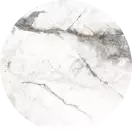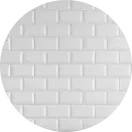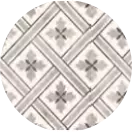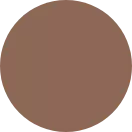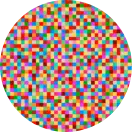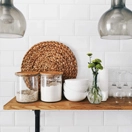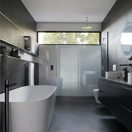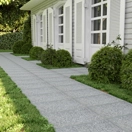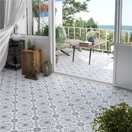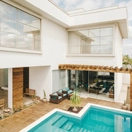Ceramics can be divided into three product groups depending on their strutcure and technical specifications.
Floor Tiles - Wall Tiles - Porcelain Tiles (Glazed and Unglazed)
- He technical specifications of a product are as important as the appearance for choosing the right product.
- Do not use wall tiles on floors or in exteriors.
- Wall tiles and porcelain tiles can be applied on walls with the right glue.
- Porcelain tiles that have low water absorption properties can conveniently be used in exteriors.
- Floor tiles should only be used outside with the right glue and waterproof, freeze-proof pointing material.
- Products from a higher class of corrosion (PEI) should be chosen for areas with heavy pedestrian traffic.
- Tiles with high non-slip properties should be used in wet areas such as around pools.
- The application area must be leveled and clean.
- Color shade and caliber (size) information must be read carefully and products with different properties should not be applied in the same area. An acceptable range of shade and size differences is an expectable reality in ceramics technology.
- If there are faulty, cracked, broken or deformed tiles, these should be set aside before use and taken back to the reseller with box/crate label information. Complaints made after the application of the product cannot be processed.
- The directions for use on the labels must be followed when preparing the glue and the pointing filling.
- It should be noted that the same color shade or product may not be available later in the case of maintenance; enough spare tiles should be stocked and stored for later use.
- Water insulation applications must be carried out in exterior spaces such as terrace, balcony, and pool.
- Extra products should be kept in its original packaging.
- Extra pointing filling left over after the application must be cleaned from the surface of the tiles before it dries. Water and a clean sponge is enough for this.
- Cleaning becomes more difficult if filling residue hardens on the surface of the tiles. In that case, only special chemicals can clean the surface of the tiles (such as Yurtbay Cleaner). Surfaces must be rinsed with water after cleaning.
- Only water and neutral cleaning products should be used to clean tiles with metallic surfaces (acidic or basic cleaning products may cause damage on the surfaces).
- The frequency of cleaning may differ depending on the area of application from weekly to daily and several times a day (based on the potential of the application area for dirtying, and the surface properties of the tiles)
- Glazed tiles (especially floor and wall tiles with glossy surfaces) may become scratched, so gel and cream cleaners should be used instead of powders.
- Ceramic tiles have common structural technical specifications according to the product group they belong to, such as breaking and flexing resistance, cracking resistance, water absorbency, frost resistance, and heat shock resistance.
- Technical specifications that vary depending on the surface properties of each product are defined separately, such as corrosiveness, stain and chemical resistance, and non-slip properties.
- Size and thickness, edge straightness, surface straightness and surface quality are also indicated with their tolerance values, depending on the product group.
- Yurtbay Seramik manufactures products according to the international standard TS EN 14411 2012, which has been accepted and published by TSE, and employs testing methods defined by this standard for product quality control.
- Our ISO 9001 Quality Management System has been certified by TÜV Austria, an international institution, and is inspected frequently.
- Product group definitions based on type of shape and water absorbency (Eb) values:
Boxes feature the following labels (example):
Produc Group : Wall Tile
Product Name: : Nuance White
Nominal Size : 20 x 50
Caliber (Working Size) : W2 (indicates space between two tiles)
Color Shade : T12 (indicates party)
Quality : Birinci / First
Production date : 190315 ( March 19, 2015)
Number – M2 : 10 / approximately 1 m2 (box)
- Mandatory changes in operational conditions (furnace, press) and the changing properties of raw materials found in nature are foundations of ceramics technology. This is why tiles in the same batch of production can vary in a certain range.
- In order to make it easier to apply the tiles and group products of a certain range together, products are classified and boxed by automatic dimension definition devices.
- If the standard foresees a range of 3 mm depending on the size produced, three groups are formed for each 1 mm range with caliber classification; these classes are caliber classes (W1, W2, W3).
- To prevent dimension problems during application, buyers must note crate and box label information, and use tiles with the same caliber information together.
- As indicated in dimension indications, and another constant in ceramics technology, it is natural for products produced at different times to display acceptable ranges of color shades.
- Thus, each batch produced is defined by a color shade class (T1, T15, T73).
- Products with the same color shade class should be applied in the same area.
- Tiles should be checked on the ground before application, and faulty tiles should not be applied if there are faults outside the range.
- V1 = THE SAME APPEARANCE (SINGLE FILE): With small and negligible differences from tile to tile, every tile has the same texture, color, shade, and motif.
- V2 = SLIGHT VARIATION There may be variations between the textures and/or patterns of the same color. The general appearance of tiles are highly similar.
- V3 = MEDIUM-LEVEL VARIATION: Colors in a tile give information about colors in other tiles, however, the density of color may be quite different. A color that seems unimportant on one tile may be the dominant color on another.
- V4 = RANDOM VARIATION / RANGE Two tiles may be of entirely different colors. Consumers may not choose tiles from a box. Tiles have a natural look due to color variations. This makes each application unique.
- Floor tiles / porcelain tiles have varying slipperiness depending on surface properties.
- Tiles with no-slip properties are called "antislip".
- Most frequently, DIN 51130 and DIN 51097 (German standards) and ASTM C1028 (wet/dry COF) and ANSI B101.3 (wet DCOF) (American standards) are used to classify non-slipperiness.
- The slip angles and friction coefficients of tiles are measured according to relevant standards, which indicates for which areas they are appropriate for use.
- Antislip products are used in areas with high slipperiness, such as pools and poolside, and insdustrial areas that becomes slippery with oil and similar products.
- Slipperiness classification for industrial areas are determined based on the slip angle in ramp tests and are grouped between R9-R13.
Classification according to DIN 51130 is as follows:
R9 : slip angle >60 – 100 / low static friction (entryways, bathrooms, kitchens)
R10 : slip angle >100 – 190 / normal static friction (storage areas)
R11 : slip angle >190 – 270 / increased static friction (restaurants, dining halls)
R12 : slip angle >270 – 350 / high static friction (industrial kitchens, fire houses)
R13 : slip angle >350 / very high static friction (leather-textile factories, oil production facilities)
- Classification based on barefeet test, DIN 51097:
Class A : incline angle >120 - 170 (corridors, saunas and resting areas where foot traffic is barefoot)
Class B : incline angle >180 - 230 (poolside showers, steps)
Class C : incline angle >240 (pool sides with incline)
- According to ASTM C1028:
SCOF 0 – 0.5 slippery product
SCOF 0.5 – 0.6 not completely safe
SCOF > 0.6 perfect friction (min. condition)
- According to ANSI B101.3:
DCOF < 0.30 slipping highly likely
DCOF 0.30-0.40 (leveled floor) , 0.30-0.42 (inclined) acceptable
DCOF > 0.42 (leveled floor) , > 0.45 (inclined) slipping unlikely (min. condition)
- Glazed tiles are grouped in five classes depending on their corrosion values. Surface corrosion resistance classification is carried out according to the test indicated in the TS EN 10545-17 standard, and defined as a value between PEI 1 and 5.
- Dark colored products have a lower PEI class than light colored products.
- When choosing a product, the usage traffic in the area should be noted, and products with the appropriate corrosion resistance (PEI class) should be used.
PEI .I : Appropriate for floors without corrosive materials, where foot traffic is barefeet or with soft-soled shoes (bathroom, bedroom, etc.)
PEI .II : Appropriate for floors where a small amount of corrosive materials may be present, and where foot traffic is with trainers or rubber-soled shoes (dining room, living areas)
PEI .III : Appropriate for floors where a small amount of corrosive materials may be present, and where foot traffic is with leather soles (corridors, hall entrances, terraces)
PEI .IV : Appropriate for floors where corrosive materials are present, and where foot traffic is heavy (pharmacy, school, hotel lobbies)
PEI .V : Appropriate for floors where corrosive materials are present, and where foot traffic is heavy (malls, cafeteria entrances, shopping aisles)
PEI.V class products also must have high stain resistance.
